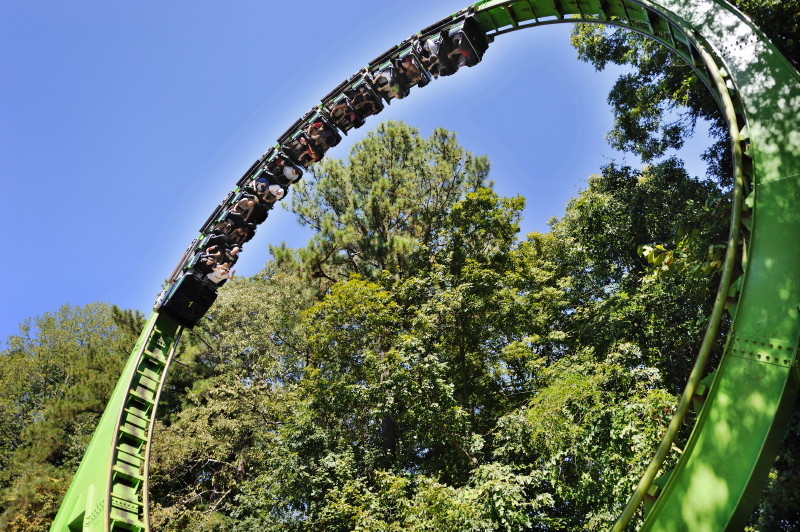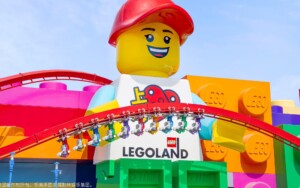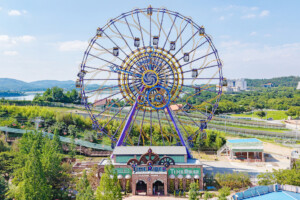Larry Wyatt (below right), Principal at Wyatt Design Group has over 30 year’s experience developing, designing and masterplanning theme park, museum and entertainment projects across the world for clients including Universal Studios, The Cincinnati Museum of Natural History and Busch Gardens. Blooloop’s Chad Emerson (below left) caught up with him.
Related: “Weird Wiring”: Disney, Urban Planning and Sneaking out of the Boat / Top 40 Magical Events at the Walt Dis ney World Resort / Leveraging Mobile Technology – The Hand Held Amusement Park Experience / Theme Park Design with Robin Hall / Building on Ideas with Theme Park Architect Bruce Green
ney World Resort / Leveraging Mobile Technology – The Hand Held Amusement Park Experience / Theme Park Design with Robin Hall / Building on Ideas with Theme Park Architect Bruce Green
Share with us how you first got started working in the amusement and recreation  industry.
industry.
I was working as an exhibit designer in Cincinnati in the mid-70’s and was exposed to Kings Productions, the in-house design and production group that oversaw all new projects and show production for the Kings Entertainment Parks: Kings Island, Kings Dominion, and Carowinds. I was so excited with the work they were doing I simply had to join the group. It looked like they were having a lot more fun than I was! Luckily, they were staffing up to begin design of a new theme park in Toronto and I snagged a key position in Architecture and Design.
The park became Canada’s Wonderland, which opened in ‘81 and I was fortunate to begin with the early planning stages of the project and follow through to opening day. It was a huge opportunity that allowed me to learn the details of developing, designing, and building a complete theme park on my first assignment. Working for the company who would operate the park, I was exposed to everything from feasibility to pre-opening operations that gave me the foundation for what I still do today: program and design theme parks and attractions. It was a wonderful experience I will never forget, and I have been hooked on the industry ever since.
What have been some of the most rewarding projects you’ve worked on and why?
In 1984 I left the theme park industry to design a small childre n’s museum at the Cincinnati Museum of Natural History—the Children’s Discovery Center. The project was the beginning of my design company and was a single focus for over a year. The exhibit was ground-breaking in that it included a storyline with a linear experience, a special effect “time machine”, interactive games and puzzles-even a pinball machine–and other elements common in today’s museum exhibits but unique at the time. Amazingly, the exhibit still exists as originally designed over 25 years ago.
n’s museum at the Cincinnati Museum of Natural History—the Children’s Discovery Center. The project was the beginning of my design company and was a single focus for over a year. The exhibit was ground-breaking in that it included a storyline with a linear experience, a special effect “time machine”, interactive games and puzzles-even a pinball machine–and other elements common in today’s museum exhibits but unique at the time. Amazingly, the exhibit still exists as originally designed over 25 years ago.
For Universal Studios Florida, I assembled a team that was responsible for design of all the set streets in the park, except for the San Francisco area. It was my first experience with a major studio, and proved to be one of the most challenging yet rewarding projects of my career. Not only was the work incredibly detailed as envisioned by Universal Creative’s Art Directors, but was also executed beautifully. I believe these set streets remain the largest set street construction project in the country if not the world. The project also opened a new universe of themed entertainment colleagues that I still work with today.
Fiesta Texas in San Antonio was my third theme park design project, but the first in which I was completely responsible for design of the entire park from start to finish. I had the benefit of a great team of designers that had just completed an amazing project for Universal Studios Florida and we simply rolled that experience into Fiesta Texas. The entire park design team, architects, engineers, construction, and operating team worked very closely together in a  truly coordinated effort. It remains in my experience the most efficient collaborative effort between all parties to design and build a completely new theme park.
truly coordinated effort. It remains in my experience the most efficient collaborative effort between all parties to design and build a completely new theme park.
Perhaps my most rewarding work was with Lego Development, with whom I began working in 1992, while Principal of the newly formed Rouse-Wyatt Associates in Cincinnati. We first designed Legoland Windsor, U.K., and then began work on Legoland California in Carlsbad. My work with Lego included internal workshops and charettes that created many of the unique child-oriented attractions found in Legoland theme parks today. The Carlsbad park was particularly rewarding, as it became the park from which all subsequent Lego parks have been modeled. Now that I live in Southern California, it has been a special treat to take our daughter Elizabeth to experience the park as a family and see her delight enjoying the elements we designed several years ago. The Themed Entertainment Association recognized the Legoland Parks with a Special Outstanding Achievement Award in 2003, which was extremely gratifying.
What about some of the most challenging ones?
Jungala for Busch Gardens Tampa was one of the more challenging projects I have completed for many reasons. This was primarily due to the complexity of integrating major animal exhibits with multi-level physical play elements, rides, food and retail facilities all on only 4 acres with lots of existing infrastructure to work around. We were part of a team of consultants based in Los Angeles and Seattle working with Busch Entertainment based in St. Louis and park management and operations in Tampa. There are several innovative elements that required a great deal of R&D as well as review with Busch Garden park operations and safety. The challenges were many and on several levels, but we all survived it and were very pleased with the final outcome.
More recently, we completed schematic design of a film studio in Wuxi, China. Now under construction, Wuxi Studios is the adaptive re-use an industrial-age steel mill plant into a full-service film and television production studio, retail complex, and entertainment destination. It was my first experience contracting directly with a District Government in China and to say many lessons were learned is a gross understatement. Not only were the schedule, project goals and client expectations extremely demanding, I found communication with the client team the biggest challenge of all. In the end, it all turned out well, but the process was agonizing. I hope what was learned along the way will better prepare us for work in the region, for I think China’s theme park and entertainment industry will remain filled with opportunity.
Currently, what types of projects are you working on and how have the continued global economic challenges influenced those projects?
All our projects are confidential, so I can’t say much about our current projects. But here’s a quick summary of what we are involved with: We just completed pre-schematic design of a new theme park in Europe for a major studio, and are wrapping up the final report for a strategic master plan for a brand flagship and entertainment destination in the U.S. We have begun preliminary planning of a new family/children’s park to be located in the U.S. and perhaps abroad. In addition, we are designing a new entertainment and leisure district adjacent to a theme park in the Pacific Rim. Like I said—I can’t reveal many details, but this shows the wide range of projects we are engaged in these days.
As with everything else today, all these projects are influenced with the challenge of raising capital to implement them. It’s now much more difficult to obtain investors and funding, get internal corporate funding approved, or get tenants committed so projects tend to start and stop frequently—often mid-phase—in response to the availability of capital to fund the design and construction. Developers now want a positive feasibility study combined with creative content first—and an impressive presentation that combines both—before getting much into the detailed design.
In general, the continued global economic challenges have forced us to approach projects differently—often combining the efforts of several specialty consultants with our planning and design resources in an integrated scope of work. This provides our clients a more comprehensive service that combines, for example: feasibility, operations, food and beverage and retail programming, and other project-specific specialists along with our in-house planning and design capability. On such projects, we find ourselves acting as project managers in addition to designers. I believe this is a reaction to companies who have reduced management staffing and overhead. Yet they seek to reduce costs, maximize efficiency, and still obtain a high level of detail for an overall design effort—and now do not have the resources to manage such an endeavor. The approach also works well for international clients who have little experience with theme park or entertainment-based projects. So we see this as a trend that is likely to continue.
In the beginning, all I wanted to do was to design great projects. Who knew one would have to wear so many hats to adapt to the rapidly evolving entertainment design industry?














